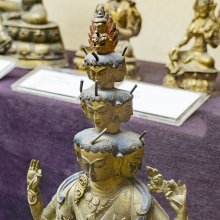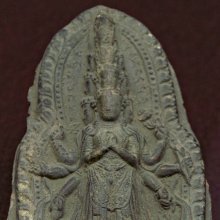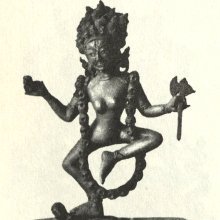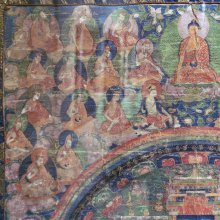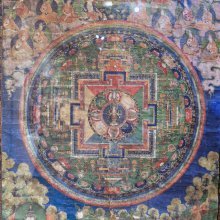Ekadashan, Ekādaśan, Ekadasha, Ekādaśa: 24 definitions
Introduction:
Ekadashan means something in Hinduism, Sanskrit, Buddhism, Pali, Marathi. If you want to know the exact meaning, history, etymology or English translation of this term then check out the descriptions on this page. Add your comment or reference to a book if you want to contribute to this summary article.
The Sanskrit terms Ekādaśan and Ekādaśa can be transliterated into English as Ekadasan or Ekadashan or Ekadasa or Ekadasha, using the IAST transliteration scheme (?).
Images (photo gallery)
(+1 more images available)
In Hinduism
Vastushastra (architecture)
Source: Brill: Śaivism and the Tantric Traditions (architecture)Ekādaśa (एकादश) refers to “eleven (digits)”, according to the Devyāmata (in the section śalyoddhāra-paṭala or “excavation of extraneous substances”).—Accordingly, “[...] If [someone] is seen to scratch his knee, there is an extraneous thing, i.e. a stump or a knee bone at a depth of one cubit. [The officiant] should remove it. If [someone] touches his shank, [the officiant] should prognosticate a bone of the shank [at a depth of] eleven digits (ekādaśa-aṅgula) underground in that place. There is no doubt about this. [...]”.

Vastushastra (वास्तुशास्त्र, vāstuśāstra) refers to the ancient Indian science (shastra) of architecture (vastu), dealing with topics such architecture, sculpture, town-building, fort building and various other constructions. Vastu also deals with the philosophy of the architectural relation with the cosmic universe.
Purana and Itihasa (epic history)
Source: archive.org: Shiva Purana - English TranslationEkādaśan (एकादशन्) refers to “eleven (crores)” (of Gaṇas), according to the Śivapurāṇa 2.3.40 (“The Marriage Procession of Śiva”).—Accordingly, as Brahmā narrated to Nārada: “[...] Rudra’s sister Caṇḍī assuming a great festive mood came there with great pleasure but inspiring terror in others. [...] The divine Bhūta attendants were crores and crores in number. They shone in diverse forms. Accompanied by them Caṇḍī of deformed face went ahead gladly and enthusiastically. She was equally competent to please and to harass. All the Gaṇas of Śiva numbering to eleven crores (ekādaśa-koṭī—koṭyekādaśasaṃkhyākā), terrible but favourites of Śiva were kept by her far behind. [...]”.

The Purana (पुराण, purāṇas) refers to Sanskrit literature preserving ancient India’s vast cultural history, including historical legends, religious ceremonies, various arts and sciences. The eighteen mahapuranas total over 400,000 shlokas (metrical couplets) and date to at least several centuries BCE.
Yoga (school of philosophy)
Source: ORA: Amanaska (king of all yogas): A Critical Edition and Annotated Translation by Jason BirchEkādaśan (एकादशन्) refers to the “eleven (days)”, according to the Amanaska Yoga treatise dealing with meditation, absorption, yogic powers and liberation.—Accordingly, as Īśvara says to Vāmadeva: “[...] [Now], I shall define the nature of that highest, mind-free absorption which arises for those devoted to constant practice. [...] And then, within a period of eleven days (ekādaśa-ahan), the body of [the Yogin] who is abiding in absorption and devoid of mind, desires to move because [it] rises up swiftly. [...]”.

Yoga is originally considered a branch of Hindu philosophy (astika), but both ancient and modern Yoga combine the physical, mental and spiritual. Yoga teaches various physical techniques also known as āsanas (postures), used for various purposes (eg., meditation, contemplation, relaxation).
Languages of India and abroad
Pali-English dictionary
Source: Sutta: The Pali Text Society's Pali-English DictionaryEkādasa, (num.) (Sk. ekādaśa) eleven Vin.I, 19.—num. ord. ekādasama the eleventh Sn.111, 113. (Page 160)

Pali is the language of the Tipiṭaka, which is the sacred canon of Theravāda Buddhism and contains much of the Buddha’s speech. Closeley related to Sanskrit, both languages are used interchangeably between religions.
Marathi-English dictionary
Source: DDSA: The Molesworth Marathi and English Dictionaryēkādaśa (एकादश).—a (S) Eleven. ē0 sthānīṃ asaṇēṃ To be on terms of the closest friendship. See explained under akarāvā.
Source: DDSA: The Aryabhusan school dictionary, Marathi-Englishēkādaśa (एकादश).—a Eleven. ēkādaśa sthānīṃ asaṇēṃ To be on terms of the closest friendship. See under akarāvā.
--- OR ---
ēkādasa (एकादस) [-śī, -शी].—f The 11th day of the waxing or of the waning moon. ēkādaśīcē gharīṃ śivarātra Used when misfortune follows
Marathi is an Indo-European language having over 70 million native speakers people in (predominantly) Maharashtra India. Marathi, like many other Indo-Aryan languages, evolved from early forms of Prakrit, which itself is a subset of Sanskrit, one of the most ancient languages of the world.
Sanskrit dictionary
Source: DDSA: The practical Sanskrit-English dictionaryEkādaśa (एकादश).—a. (-śī f.)
1) Eleventh. आत्मैकादशः (ātmaikādaśaḥ) Bṛ. Up. 3.9.4.
2) Consisting of eleven.
3) Lasting for eleven months.
-śī 1 The eleventh day of every fortnight of a lunar month, sacred to Viṣṇu; (when fasting is enjoined and is considered to be productive of great religious merit).
2) Presentations of offerings to deceased ancestors or Pitṛs on the eleventh day after decease.
-śam The number eleven
Source: Cologne Digital Sanskrit Dictionaries: Edgerton Buddhist Hybrid Sanskrit DictionaryEkādaśā (एकादशा).—(by em.), (1) name of a devakumārikā in the west: Lalitavistara 390.6; mss. Ekāhaṃśa-, Ekāndaśā, °dasā; in parallel Mahāvastu iii.308.9 mss. Ekānavā (v.l. °naṃ-vā); Tibetan not quoted by Foucaux; (2) a king of musical instrument, = next: Mahāvastu iii.442.11 (prose; mss. ekāśā, em. Senart); read ekādaśāṃ (acc. sg.) also, with one ms. (v.l. °śa), in Mahāvastu iii.82.4 (Senart em. °daśīṃ!).
Source: Cologne Digital Sanskrit Dictionaries: Shabda-Sagara Sanskrit-English DictionaryEkādaśa (एकादश).—mfn.
(-śaḥ-śī-śaṃ) Eleven, eleventh. f. (-śī) The eleventh day of the half month: it is especially sacred to Vishnu and fasting on it is most efficacious. E. ekādaśan eleven, affix ḍa.
Source: Cologne Digital Sanskrit Dictionaries: Shabda-Sagara Sanskrit-English DictionaryEkādaśan (एकादशन्).—plur. mfn. (-śa) Eleven. E. eka one, daśan ten, with āṅ inserted.
Source: Cologne Digital Sanskrit Dictionaries: Benfey Sanskrit-English DictionaryEkādaśa (एकादश).—i. e. ekādaśan + a. I. ord. numb., f. śi. 1. The eleventh, [Mānavadharmaśāstra] 3, 47. 2. Lasting eleven (months), Mahābhārata 13, 4247. Ii. f. śī, The eleventh day of the half month, Mahābhārata 13, 4234.
Source: Cologne Digital Sanskrit Dictionaries: Benfey Sanskrit-English DictionaryEkādaśan (एकादशन्).—i. e. eka-daśan, card. numb. pl. Eleven, [Mānavadharmaśāstra] 2, 89.
Source: Cologne Digital Sanskrit Dictionaries: Cappeller Sanskrit-English DictionaryEkādaśa (एकादश).—[feminine] ī the eleventh.
Source: Cologne Digital Sanskrit Dictionaries: Cappeller Sanskrit-English DictionaryEkādaśan (एकादशन्).—[adjective] eleven.
Source: Cologne Digital Sanskrit Dictionaries: Monier-Williams Sanskrit-English Dictionary1) Ekādaśa (एकादश):—[from eka] a mf(ī)n. the eleventh, [Ṛg-veda x, 85, 45; Śatapatha-brāhmaṇa; Manu-smṛti] etc.
2) [v.s. ...] ( [v] ṛṣabhaikādaśā gāvas, ‘cows that have a bull as the eleventh’ id est. ten cows and one bull, [Gautama-dharma-śāstra; Manu-smṛti] etc.)
3) [v.s. ...] together with eleven, plus eleven, [Vopadeva]
4) [v.s. ...] consisting of eleven, lasting eleven (e.g. months), [Ṛg-veda; Atharva-veda v, 16, 11; Mahābhārata] etc.
5) [from eka] n. the number eleven, [Śatapatha-brāhmaṇa 2.]
6) [v.s. ...] b (in [compound] for ekādaśan below)
Source: Cologne Digital Sanskrit Dictionaries: Monier-Williams Sanskrit-English DictionaryEkādaśan (एकादशन्):—[from eka] mfn. eleven.
Source: Cologne Digital Sanskrit Dictionaries: Yates Sanskrit-English DictionaryEkādaśa (एकादश):—[(śaḥ-śī-śaṃ) a.] Eleven, (śī f.) a day sacred to Vishnu.
Source: Cologne Digital Sanskrit Dictionaries: Yates Sanskrit-English DictionaryEkādaśan (एकादशन्):—(śa) a. Eleven.
[Sanskrit to German]
Sanskrit, also spelled संस्कृतम् (saṃskṛtam), is an ancient language of India commonly seen as the grandmother of the Indo-European language family (even English!). Closely allied with Prakrit and Pali, Sanskrit is more exhaustive in both grammar and terms and has the most extensive collection of literature in the world, greatly surpassing its sister-languages Greek and Latin.
Kannada-English dictionary
Source: Alar: Kannada-English corpusĒkādaśa (ಏಕಾದಶ):—
1) [adjective] totalling to eleven.
2) [adjective] occurring, happening, being etc. after the tenth, in a series; following the tenth in order; eleventh.
--- OR ---
Ēkādaśa (ಏಕಾದಶ):—[noun] the cardinal number eleven; 11.
Kannada is a Dravidian language (as opposed to the Indo-European language family) mainly spoken in the southwestern region of India.
See also (Relevant definitions)
Partial matches: Dasa, Eka, Tacan, Taca.
Starts with: Ekadashadina, Ekadashakapala, Ekadashamsha, Ekadashangula, Ekadasharashika, Ekadashavasara.
Full-text (+67): Ekadasa, Ekadashaha, Ekadashatva, Ekadashamarika, Tryambaka, Ekadashadvara, Ekadashaka, Ekadashakapala, Ekadashottama, Kapardin, Aparajita, Hara, Ekadashavarsha, Ekadashavidha, Bahurupa, Ekadashakritvas, Ekadashavishnuganashraddha, Ekadashaskandharthanirupanakarika, Ekadashacchadi, Vrishakapi.
Relevant text
Search found 36 books and stories containing Ekadashan, Ekā-daśa, Eka-dashan, Eka-dasa, Ekā-daśan, Ekadasan, Ekādaśan, Eka-dasan, Eka-dasha, Ekadasha, Ekādaśa, Ekadasa; (plurals include: Ekadashans, daśas, dashans, dasas, daśans, Ekadasans, Ekādaśans, dasans, dashas, Ekadashas, Ekādaśas, Ekadasas). You can also click to the full overview containing English textual excerpts. Below are direct links for the most relevant articles:
Rig Veda (translation and commentary) (by H. H. Wilson)
Tattvartha Sutra (with commentary) (by Vijay K. Jain)
Verse 9.11 - Eleven afflictions figuratively occur to the Omniscient Jina < [Chapter 9 - Stoppage and Shedding of Karmas]
Chandogya Upanishad (english Translation) (by Swami Lokeswarananda)
Verse 8.11.3 < [Section 8.11]
Manusmriti with the Commentary of Medhatithi (by Ganganatha Jha)
Verse 2.92 < [Section XVIII - Control of Sensual Desires]
Cidgaganacandrika (study) (by S. Mahalakshmi)
Verse 164 [Ekādaśa-varṇa] < [Chapter 3 - Third Vimarśa]
Garga Samhita (English) (by Danavir Goswami)
Verse 2.13.17 < [Chapter 13 - The Story of Śeṣa]
Verse 4.6.28 < [Chapter 6 - The Story of the Ayodhyā Women]
Related products
